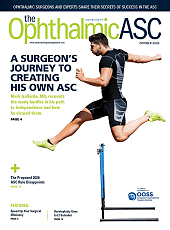Since a study published in 2024 found that patients taking GLP-1 drugs may be at higher risk of developing ophthalmic disease, researchers have been working to learn more about a possible connection to vision loss. Two new studies presented this week at the 129th annual meeting of the American Academy of Ophthalmology offer mixed results: one found GLP-1 drugs can increase the risk of diabetic retinopathy (DR) and nonarteritic anterior ischemic optic neuropathy (NAION), while another study suggests the drug may offer protection against dry age-related macular degeneration (AMD).
Researchers in an international collaboration across the University of Ottawa Eye Institute, University of Toronto, McMaster University, and Doheny Eye Institute UCLA conducted one of the largest global studies on the topic to date, noted the AAO in a press release. Using data from the World Health Organization's global database of drug safety reports, the authors analyzed data on 117,173 patients with diabetes taking semaglutide (GLP-1 drugs), empagliflozin, exenatide, tirzepatide, or insulin.
Results showed that people using GLP-1 drugs were 68.6 times more likely to develop NAION and 8 times more likely to develop DR than those taking empagliflozin, exenatide, insulin, or metformin. The analysis found no significant association between the GLP-1 tirzepatide and NAION or DR.
“My hope is that these findings empower patients and clinicians to make informed choices among the many GLP-1 receptor agonists now available,” said Moiz Lakhani, a medical student at the University of Ottawa. “Patients deserve proactive care that includes documenting a baseline eye history, counseling on early visual symptoms, and streamlined referral pathways to ophthalmology, so that emerging issues can be identified and managed without interrupting access to these therapies.”
In a separate study, researchers at Cleveland Clinic Cole Eye Institute evaluated the effect of GLP-1 drugs on the risk of developing AMD.
Researchers looked at data from more than 430,000 patients aged 50 and older who took either a GLP-1, sodium-glucose cotransporter 2 inhibitors (SGLT2i), metformin or insulin to manage their diabetes for at least 2 years. All patients were seen at a single ophthalmic center, which allowed the authors to manually review all AMD cases identified by ICD-10 coding.
The 7,319 patients taking a GLP-1 for 5 years showed a significantly lower risk of developing dry AMD: 63% lower than patients on metformin, 58% lower risk than patients on insulin, and 54% lower risk than those taking a SGLT2i. The protective effect increased among patients followed for up to 5 years. The analysis showed no significant protection against the wet form of AMD.
“While the role of GLP-1RA on AMD is still being debated, this study shows a protective effect of GLP-1RA on nonexudative AMD development compared to other antihyperglycemic agents. This study was also the first to investigate the effect of GLP-1 on AMD compared to SGLT2i,” said lead researcher Julia Joo, MD.
The authors of both studies conclude that more long-term studies are required to determine the effect of GLP-1 drugs on eye health. They also endorse the conclusion of both the American Academy of Ophthalmology and the North American Neuro-Ophthalmology Society: Patients who develop NAION while on GLP-1 drugs should engage in a shared decision-making process with their physicians, including their ophthalmologist, neurologist, primary care physician, or endocrinologist. This discussion should consider the individual's overall health, risk factors, and therapeutic options to make an informed decision about whether to continue or discontinue GLP-1 drugs.








